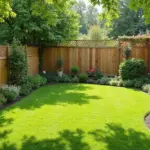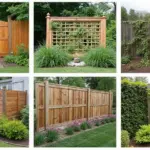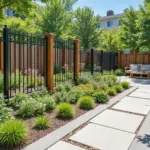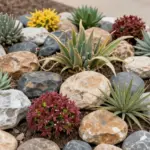Your front porch ceiling plays a crucial role in defining your home’s curb appeal and creating that perfect welcoming atmosphere we all crave. Whether you’re dealing with a tired-looking overhead space or planning a complete porch makeover, the right ceiling design can transform your outdoor living area from ordinary to extraordinary.
We’ve discovered that homeowners often overlook this powerful design element, missing out on countless opportunities to add character, style, and even functionality to their porch spaces. From classic beadboard and elegant coffered designs to modern wood planks and eye-catching painted finishes, the possibilities are virtually endless.
The best part? Most front porch ceiling projects are surprisingly achievable for DIY enthusiasts while offering dramatic visual impact that’ll make your neighbors take notice. Ready to explore ceiling ideas that’ll elevate your porch from basic to breathtaking?
Classic Beadboard Ceiling Ideas for Timeless Appeal
Beadboard ceilings bring cottage charm and architectural interest to any front porch design. We’ve seen this classic material transform ordinary outdoor spaces into welcoming retreats that stand the test of time.
Traditional White Beadboard Installation
White beadboard creates a crisp, clean foundation that complements virtually any porch style or color scheme. We recommend using moisture resistant MDF or vinyl beadboard panels for durability against weather elements. Installation typically involves securing panels directly to ceiling joists with construction adhesive and finishing nails spaced 16 inches apart.
Preparation starts with measuring your ceiling space and purchasing 10% extra material to account for cuts and waste. We suggest priming all surfaces before installation to prevent moisture damage and ensure proper paint adhesion. Traditional white beadboard pairs beautifully with dark exterior trim, creating striking contrast that enhances your home’s architectural details.
Maintenance requires annual cleaning with mild soap solution and touch up painting every 2-3 years depending on climate exposure. We’ve found that semi gloss or satin paint finishes work best for easy cleaning while providing adequate protection against humidity and temperature changes.
Painted Beadboard in Bold Colors
Colored beadboard ceilings add personality and visual drama to front porch spaces that need extra character. We love using deep blues, sage greens, or charcoal grays to create sophisticated outdoor rooms that feel intentionally designed. Bold ceiling colors work particularly well with white or neutral wall colors, creating balanced contrast without overwhelming the space.
Color selection should complement your home’s existing exterior palette while considering the porch’s orientation and natural light exposure. We recommend testing paint samples on small beadboard sections during different times of day to observe how colors appear under various lighting conditions. Darker colors can make low ceilings feel more intimate, while lighter bold colors maintain an airy feeling.
Application requires the same preparation steps as white beadboard, with additional attention to primer selection for optimal color coverage. We suggest using high quality exterior paint specifically formulated for porch ceilings to ensure longevity and fade resistance against UV exposure.
Stained Beadboard for Natural Wood Tones
Stained beadboard showcases natural wood grain patterns while providing rich, warm ceiling treatments that complement rustic or traditional home styles. We prefer using cedar or pine beadboard for staining projects because these woods accept stain evenly and offer excellent weather resistance. Popular stain colors include honey oak, weathered gray, and classic walnut tones.
Wood preparation involves light sanding with 220 grit sandpaper to ensure smooth stain penetration and even color distribution. We always recommend applying wood conditioner before staining to prevent blotchy results, especially with softer woods like pine. Two coats of exterior grade stain provide optimal protection and color depth.
Sealing requires applying clear polyurethane or marine grade topcoat annually to protect against moisture damage and UV fading. We’ve observed that properly maintained stained beadboard ceilings can last 8-10 years before requiring refinishing, making them an excellent long term investment for porch renovations.
Exposed Beam Ceiling Designs for Rustic Charm
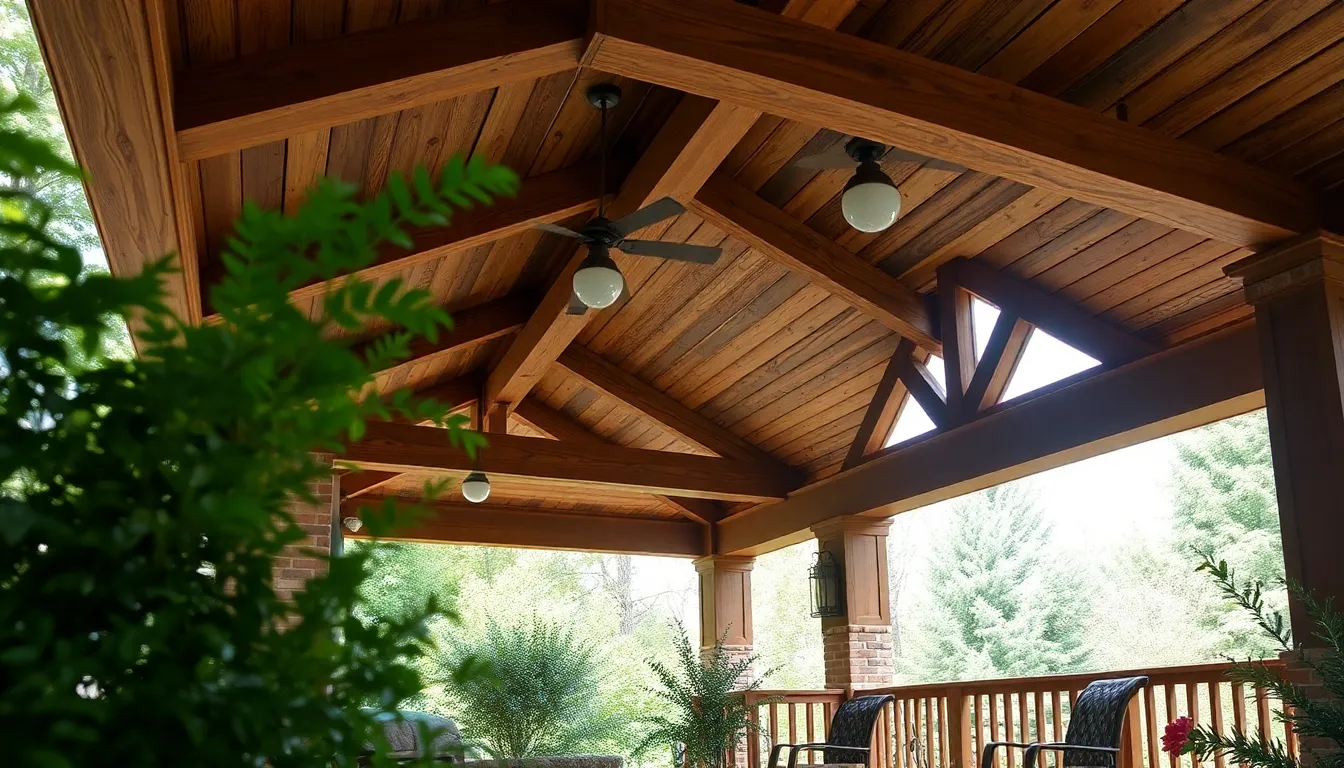
Moving beyond traditional beadboard options, exposed beam ceilings create a dramatic architectural statement that transforms any front porch into a welcoming outdoor retreat. These designs showcase natural wood textures while adding substantial visual weight and character to your ceiling space.
Reclaimed Wood Beam Installation
Installing reclaimed wood beams brings authentic character and sustainable building practices to your porch ceiling project. These weathered beams carry natural patina and history that can’t be replicated with new materials. We recommend sourcing beams from old barns, warehouses, or demolished structures to achieve genuine vintage appeal.
Preparation involves cleaning and treating the reclaimed wood to ensure structural integrity without compromising its aged appearance. Check each beam for pest damage, rot, or structural weaknesses before installation. Most reclaimed beams work well with traditional spacing patterns, typically installed 3 feet apart for larger 4×8 beams or 2 feet on center for smaller rafters.
Pairing reclaimed beams with tongue and groove or beadboard ceiling finishes creates an elegant blend of rustic and refined elements. This combination allows the natural wood character to shine while providing a polished backdrop. The contrast between weathered beams and crisp ceiling planks adds visual depth and sophistication to your porch design.
Painted Beam Contrast Options
Creating visual contrast through strategic beam painting transforms exposed rafters into striking architectural features. Charcoal or black painted beams against lighter ceiling boards deliver dramatic visual balance while maintaining rustic warmth. This approach combines traditional craftsmanship with contemporary design sensibilities.
White or pastel painted beams paired with darker ceiling planks brighten the entire porch space while emphasizing structural details. Light colored beams reflect more natural light, making covered porches feel more open and airy. We’ve seen excellent results when homeowners match beam colors to their home’s trim for cohesive design flow.
Dark painted beams create depth and visual interest when combined with textured ceiling planks or natural wood finishes. Deep colors like navy, forest green, or rich brown add sophistication while highlighting the beam’s structural importance. These bold choices work particularly well on larger porches where dramatic elements won’t overwhelm the space.
Decorative Beam Spacing Techniques
Strategic beam spacing affects both structural integrity and the visual rhythm of your porch ceiling design. Standard exposed rafter spacing uses 2×8 rafters placed 2 feet on center, creating a regular pattern that emphasizes order and craftsmanship. Larger 4×8 beams can be spaced 3 feet apart for a more open, grand appearance.
Adding false beams perpendicular to structural rafters creates elegant coffered ceiling patterns without compromising strength. This technique works especially well on flat porch ceilings where you want to add visual interest and architectural detail. False beams can be constructed from lightweight materials and attached to the ceiling surface for easy installation.
Varying beam spacing intentionally adds rustic irregularity and charm to traditional porch designs. Uneven spacing patterns work well with reclaimed wood beams where authentic barn or cabin aesthetics are desired. We recommend maintaining some visual balance while allowing for slight variations that enhance the handcrafted appearance.
Tongue and Groove Ceiling Treatments
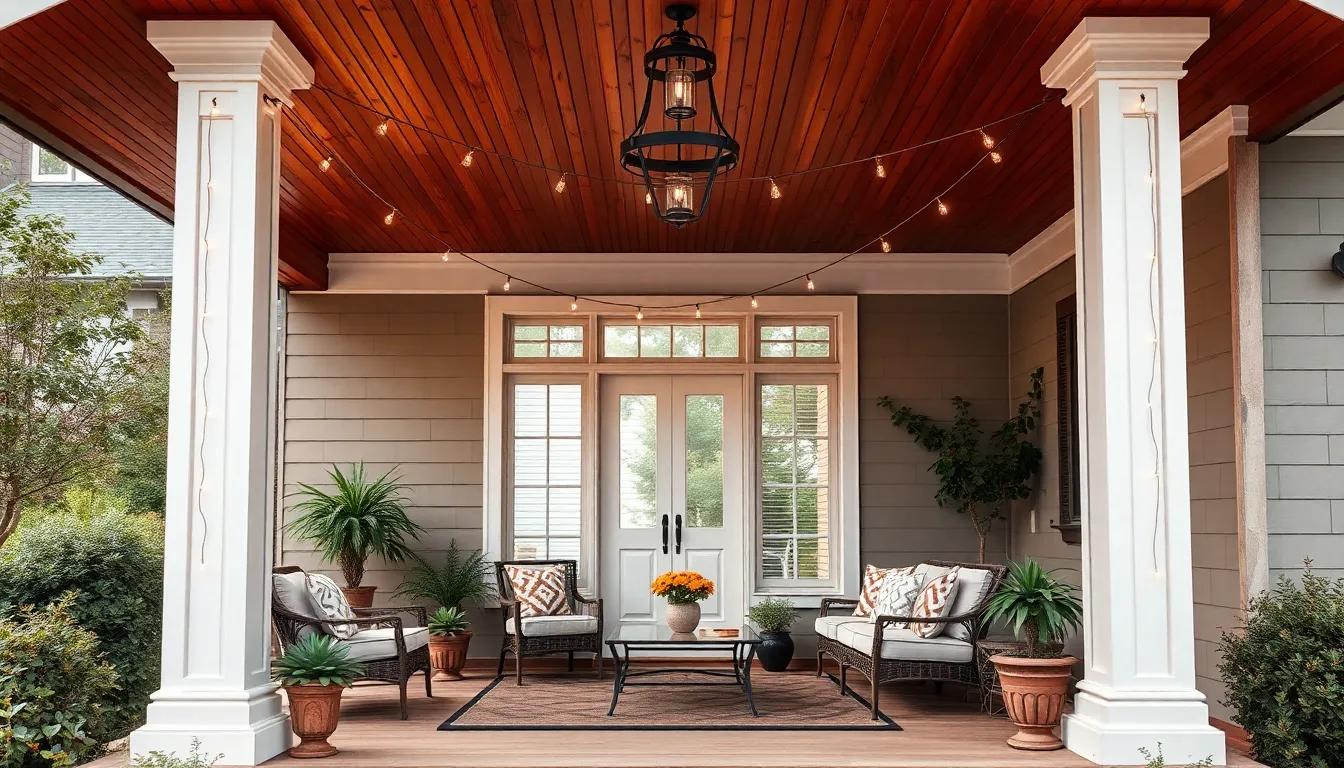
Tongue and groove ceilings bring timeless elegance to front porches with their interlocking wooden planks that create seamless, sophisticated surfaces. This classic installation method offers exceptional durability while delivering the clean lines that complement both traditional and modern porch designs.
Pine Tongue and Groove Planking
Pine planking delivers affordability without sacrificing the warm, inviting atmosphere that makes porches feel welcoming. Visible grain patterns add natural texture and charm that works beautifully with farmhouse and traditional home styles. Installation becomes straightforward since pine’s lightweight nature makes it easy to handle during DIY projects.
Unfinished pine creates rustic appeal that ages gracefully over time. Staining enhances the natural grain while maintaining the wood’s organic character. Painted pine transforms into a polished surface that matches any color scheme you envision for your outdoor space.
Protection matters with pine installations, so we recommend applying quality sealants to resist moisture and weather damage. Regular maintenance keeps pine looking fresh and extends its lifespan significantly.
Cedar Tongue and Groove Applications
Cedar applications provide superior durability with natural resistance to insects and rot that makes outdoor installations worry free. Rich color ranges from reddish tones to lighter hues create visual interest that develops beautiful patina when left natural. Aromatic qualities add sensory appeal that enhances your porch experience every time you step outside.
Natural oils in cedar help it withstand outdoor conditions without warping or cracking like other wood species. Installation costs more than pine initially, but cedar’s longevity makes it a smart investment for homeowners seeking premium results.
Upscale appearance comes naturally with cedar’s refined grain patterns and consistent coloring. Staining maintains the original color while allowing the wood’s character to shine through.
Painted Tongue and Groove Finishes
Painted finishes offer unlimited customization options that let you match any architectural style or personal preference. Light blue paint, often called “haint blue,” remains the most popular choice because it deters insects while reflecting light to brighten porch spaces naturally.
Smooth, uniform surfaces result from quality paint applications that hide wood imperfections and create clean, professional looks. Dark painted finishes like black or charcoal deliver dramatic, modern aesthetics that work especially well with farmhouse decor elements and string lighting displays.
Protection benefits multiply when paint creates an extra barrier against moisture and UV damage that extends wood life significantly. Color matching becomes simple when you coordinate ceiling paint with existing porch elements and home exterior colors.
Black tongue and groove ceilings provide sleek, structured appearances that contrast beautifully with lighter walls and decorative lighting fixtures.
Coffered Ceiling Ideas for Elegant Sophistication
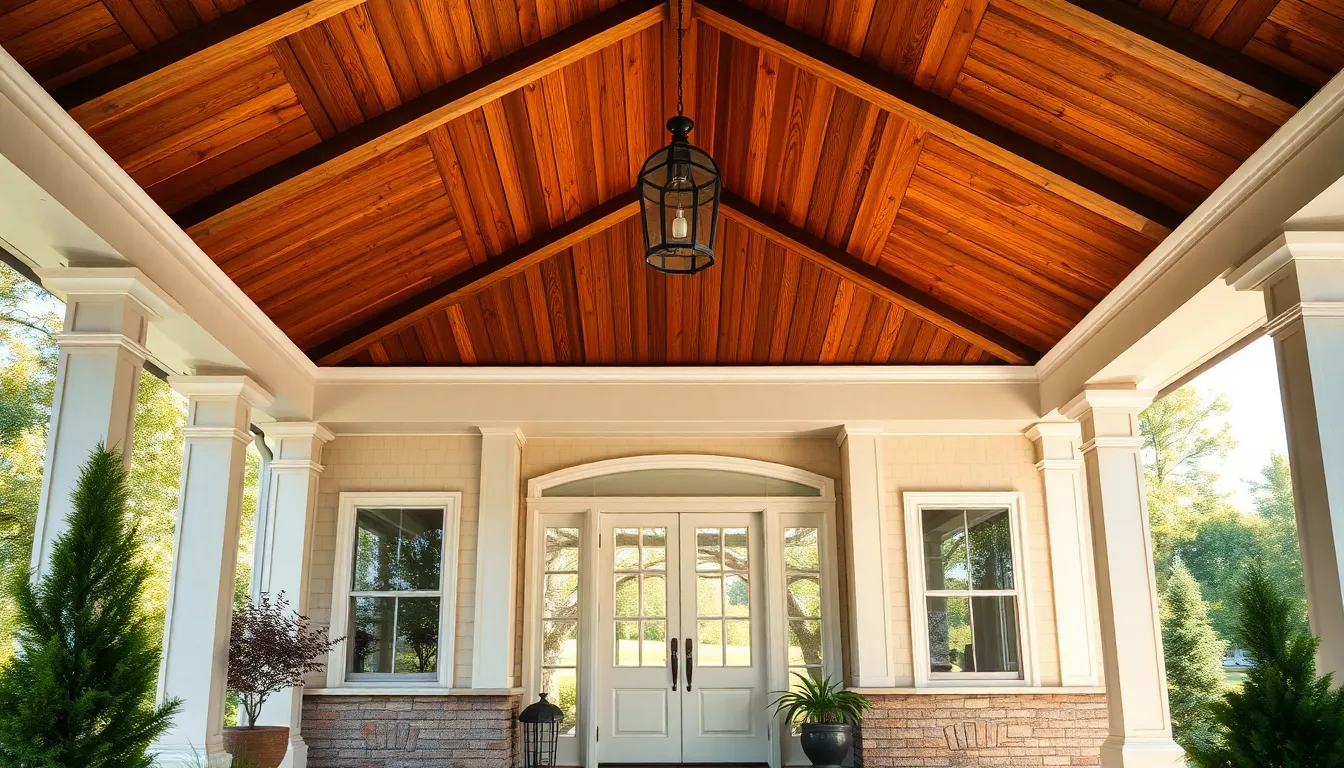
Coffered ceilings bring architectural sophistication to front porches through carefully designed recessed panels that create depth and visual interest. These grid-like patterns transform ordinary porch ceilings into stunning focal points that enhance your home’s overall elegance.
Traditional Coffered Panel Designs
Traditional coffered panels showcase timeless craftsmanship through structured grid patterns that complement colonial and rustic home styles. Wood tongue and groove boards fit within sturdy beams to create the classic recessed panel effect we’ve admired for generations. Rich wood tones and stained finishes add warmth while highlighting the natural grain patterns that make each installation unique.
Structured beams frame each panel section to create the distinctive grid layout that defines traditional coffered design. These installations emphasize depth and shadow play throughout the day as sunlight shifts across the porch ceiling. Craftsmanship details like precise joinery and quality materials ensure your coffered ceiling ages beautifully while maintaining its elegant appearance.
Modern Simplified Coffered Patterns
Modern coffered designs simplify traditional patterns by using wider beams and fewer recessed sections for a clean, contemporary look. Sleek lines replace ornate detailing while maintaining the sophisticated depth that makes coffered ceilings so appealing. False beams installed perpendicular to structural rafters create the coffered effect without complex construction requirements.
Contemporary materials like painted wood or composite options provide durability while achieving the minimalist aesthetic that modern homeowners prefer. Larger panel sections reduce visual complexity while still delivering the architectural interest that elevates porch design. These streamlined patterns work perfectly with transitional home styles that blend traditional and modern elements.
Painted Coffered Ceiling Variations
Painted coffered ceilings offer endless customization possibilities while protecting wood materials from outdoor elements. White and soft neutral colors enhance light reflection to create bright, airy porch spaces that feel welcoming throughout the day. Blue and soft pastel finishes evoke sky-like effects that add Southern charm to any porch setting.
Contrasting color schemes highlight beam structures against ceiling panels to accentuate the coffered pattern’s geometric beauty. Dark beams paired with light panels create dramatic visual impact while maintaining sophisticated elegance. Paint protection extends the lifespan of outdoor wood installations while allowing you to update colors as design preferences evolve over time.
Tin Ceiling Tiles for Vintage Character
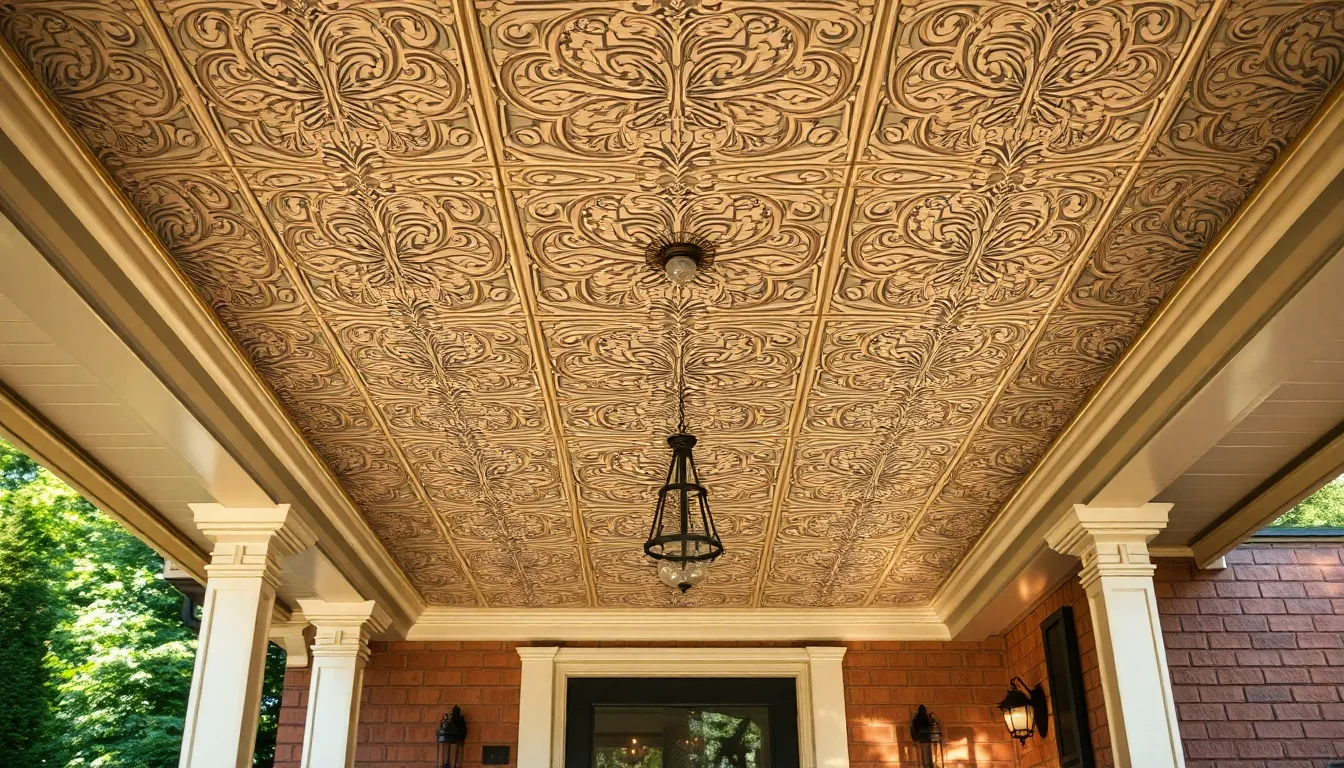
Tin ceiling tiles offer an exceptional way to infuse your front porch with historical charm and architectural elegance. These decorative elements originated in the late 19th century as an affordable alternative to ornate plasterwork, instantly transforming ordinary ceilings into stunning focal points that complement traditional, farmhouse, or Victorian-style homes.
Pressed Tin Tile Installation Methods
Installing pressed tin ceiling tiles requires careful preparation and the right techniques to ensure lasting durability in outdoor environments. We recommend starting with a solid wood substrate such as plywood or beadboard to provide proper support for the metal tiles.
Preparation Steps:
- Measure ceiling dimensions precisely to calculate tile quantities
- Cut tiles using metal snips or tin shears for clean edges
- Clean the substrate surface thoroughly before installation
Installation Process:
- Apply construction adhesive designed for metal surfaces
- Secure tiles with galvanized nails or screws to prevent rust
- Seal all seams with exterior-grade caulking to block moisture penetration
- Add a backer board beneath tiles when extra support is needed
This installation method preserves both the aesthetic appeal and structural integrity of tin ceilings, especially important for covered porch applications where weather protection is essential.
Decorative Tin Tile Pattern Options
Choosing the right pattern dramatically influences your porch’s overall style and visual impact. Embossed tin tiles feature various decorative motifs that range from ornate Victorian designs to streamlined geometric patterns.
Traditional Pattern Choices:
- Floral and scroll designs create ornate, period-appropriate aesthetics
- Victorian-inspired motifs add authentic historical character
- Intricate botanical patterns complement garden-style porches
Contemporary Pattern Options:
- Geometric shapes contribute to Art Deco-inspired looks
- Symmetrical repetitive patterns enhance existing architectural details
- Linear designs create modern yet timeless appeal
Strategic pattern mixing allows us to create unique focal points while maintaining visual harmony. Consider using simpler patterns for larger ceiling areas and reserving ornate designs for accent sections or borders.
Painted Tin Ceiling Finishes
Painting tin ceiling tiles serves dual purposes: customization and protection against outdoor elements. Popular finish options range from classic whites to bold contemporary colors that complement your home’s exterior palette.
Classic Finish Options:
- Glossy white or cream brightens porch spaces and reflects natural light
- Metallic finishes in bronze, copper, or silver maintain vintage authenticity
- Pewter tones provide subtle sophistication without overwhelming brightness
Modern Color Approaches:
- Bold colors like black or charcoal create striking contrast with white trim
- Navy blue or forest green complement traditional home exteriors
- Warm grays offer contemporary neutrals that work with various architectural styles
Paint application protects the metal from rust and weathering while allowing complete color customization. Black painted tin tiles paired with industrial lighting fixtures create an especially stylish urban-industrial porch aesthetic that balances vintage charm with modern sensibilities.
Outdoor Fabric Ceiling Draping
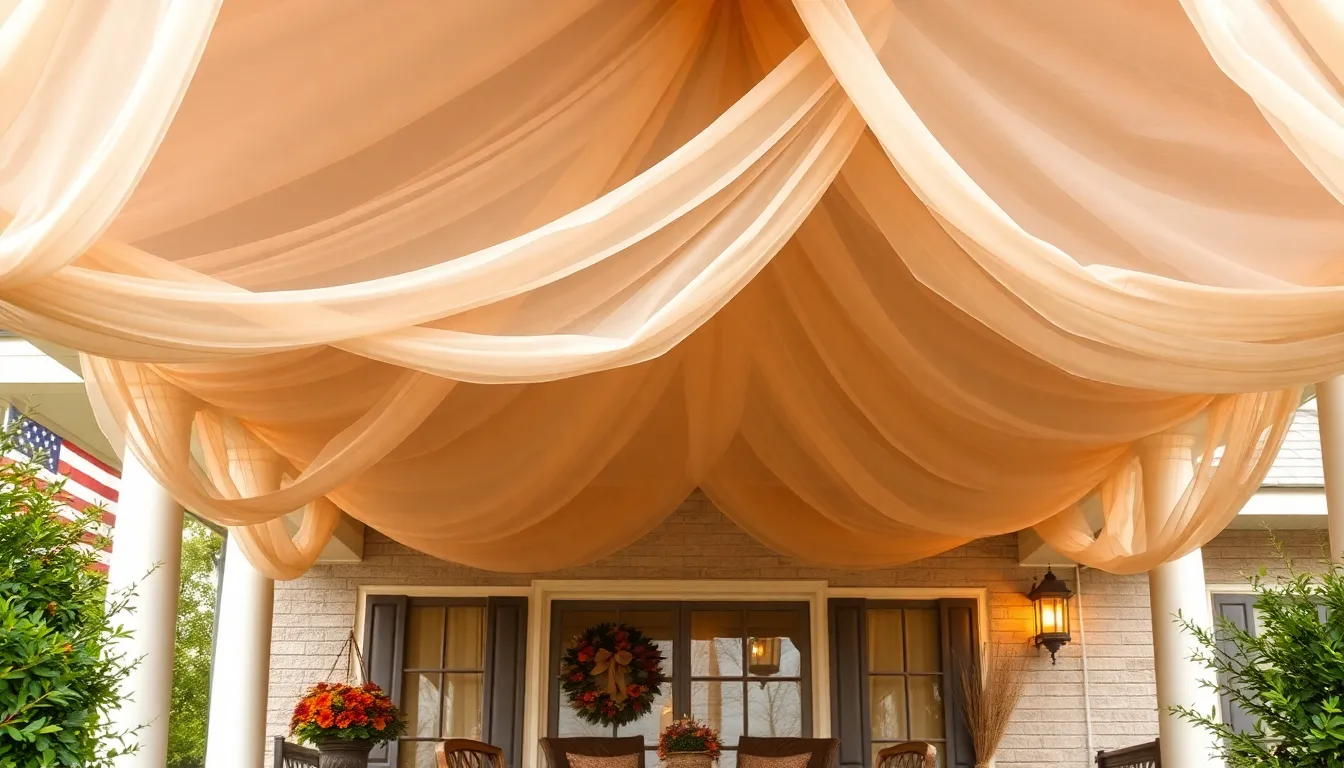
We’ve explored solid ceiling materials, but fabric draping offers an entirely different approach that brings softness and elegance to outdoor spaces. This versatile option transforms porch ceilings with flowing textures while providing practical benefits like hiding imperfections and creating intimate atmospheres.
Weather-Resistant Fabric Selection
Choosing the right fabric determines your ceiling’s longevity and appearance over time. UV-resistant voile delivers exceptional durability while maintaining its translucent beauty through intense sunlight exposure. Canvas provides robust protection against rain and humidity, making it ideal for porches with limited overhead coverage.
Treated outdoor fabrics specifically designed for exterior use resist fading and deterioration that plague standard indoor materials. These specialized textiles prevent mold and mildew formation in humid conditions, ensuring your ceiling remains fresh and attractive. Marine grade fabrics offer premium weather resistance for coastal environments where salt air creates additional challenges.
| Fabric Type | UV Resistance | Water Resistance | Durability Rating |
|---|---|---|---|
| UV-Resistant Voile | Excellent | Good | 5-7 years |
| Canvas | Very Good | Excellent | 7-10 years |
| Marine Grade | Excellent | Excellent | 10+ years |
Fabric Installation Techniques
Stretching fabric taut across ceiling beams creates the most professional appearance and prevents sagging over time. We secure the material using heavy duty staples spaced every 6 inches along wooden supports for maximum holding power. Hidden fasteners provide cleaner aesthetics when appearance takes priority over installation speed.
Covering seams with decorative lath strips creates finished edges while adding structural reinforcement to high stress areas. Vaulted ceiling installations require strategic tension adjustments to accommodate varying angles and prevent fabric pooling. Flat porch ceilings allow for simpler mounting methods using standard wood strips or metal tracks.
Creating gentle draping effects involves intentionally loosening fabric sections between support points for visual softness. This technique works particularly well with lightweight voile that moves gracefully in outdoor breezes.
Seasonal Fabric Ceiling Changes
Adapting fabric choices throughout the year keeps porches feeling fresh and seasonally appropriate. Lightweight voile and canvas excel during warmer months by allowing air circulation while filtering harsh sunlight. These breathable materials create comfortable shade without trapping heat underneath.
Heavier insulating fabrics provide warmth during cooler seasons while maintaining the cozy atmosphere that makes porches inviting year round. Switching between seasonal options encourages regular maintenance and allows for style updates without permanent commitments.
Color changes enhance seasonal themes, with warm earth tones for autumn installations and bright whites or pastels for spring refreshes. This flexibility transforms the same space multiple times annually, maximizing design impact and keeping outdoor living areas captivating throughout changing weather patterns.
Bamboo Ceiling Panels for Natural Texture
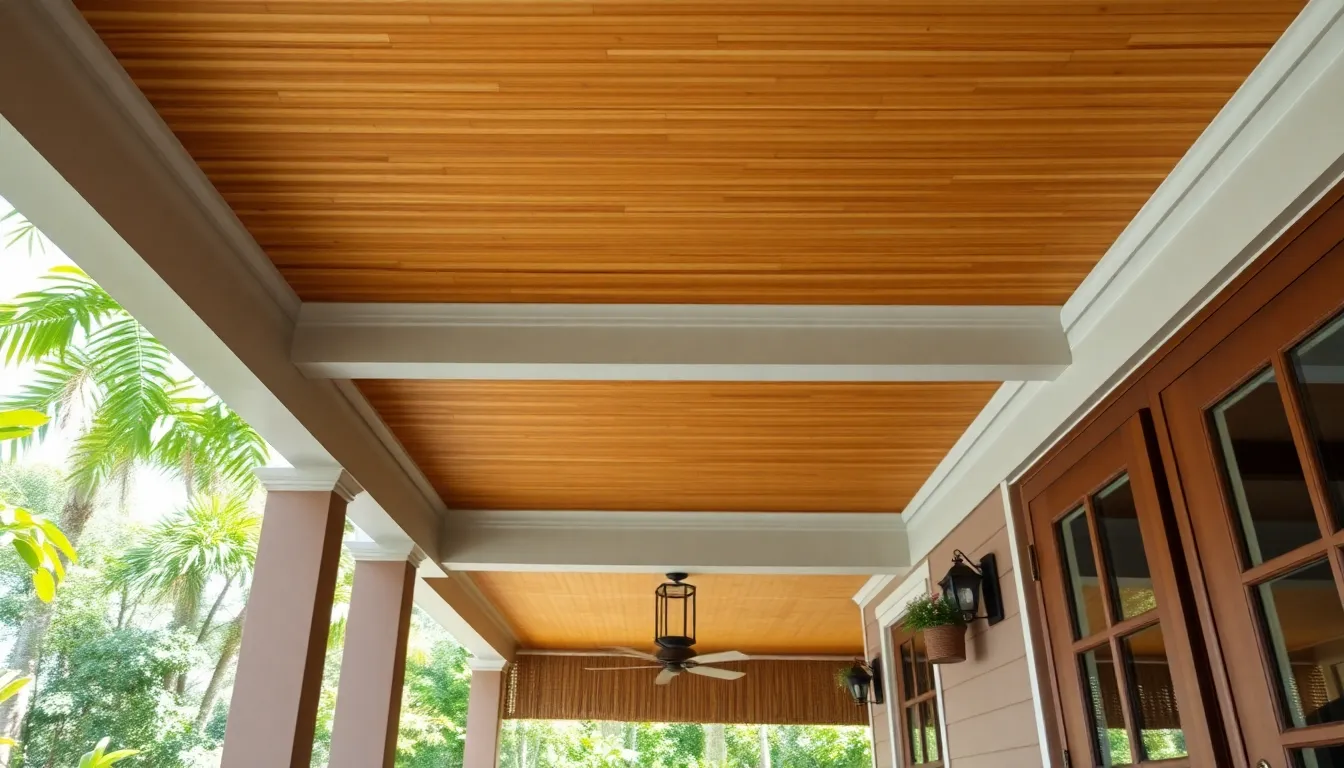
Bamboo ceiling panels transform front porches with sustainable materials that bring warmth and organic beauty to outdoor spaces. We love how these eco-friendly panels create tropical vibes while offering the durability needed for porch environments.
Bamboo Panel Installation Process
Installation begins with measuring and cutting bamboo strips or panels to fit your ceiling dimensions using circular and cross-cut saws. We recommend attaching the bamboo directly to existing ceiling frames or rafters using screws, nails, or metal rods for maximum stability.
Binding panels with sisal twine creates an authentic natural look that enhances the bamboo’s organic appeal. Options include installing full ceiling coverage or using bamboo as decorative accent sections in key areas for visual interest.
Preparation involves ensuring your ceiling frame can support the bamboo’s weight and checking for proper ventilation to prevent moisture buildup. We suggest starting installation from one corner and working systematically across the ceiling for the best results.
Bamboo Ceiling Treatment Options
Natural oils and sealants preserve bamboo’s original color while providing essential moisture resistance for outdoor applications. We apply these treatments before installation to ensure complete coverage and protection.
Carbonization offers a unique treatment option where bamboo gets rolled in coals to create a rich, smoky finish with deeper color tones. This process darkens the bamboo naturally without chemicals while maintaining its structural integrity.
Varnish and polyurethane coatings provide robust protection against weather exposure and daily wear in high-traffic porch areas. We choose marine-grade finishes for maximum durability in outdoor environments.
Untreated bamboo maintains its raw, natural aesthetic but requires careful consideration of weather exposure and potential maintenance needs. This option works best in covered porches with minimal direct moisture contact.
Bamboo Ceiling Maintenance Tips
Regular dusting with soft cloths removes dirt and debris that can accumulate on bamboo surfaces over time. We clean gently with slightly damp cloths, avoiding excessive water that could cause warping or mold growth.
Moisture control prevents the most common bamboo ceiling problems by ensuring proper ventilation and addressing any leaks immediately. Excessive humidity can lead to mold, mildew, or structural damage that compromises the bamboo’s integrity.
Protective treatment reapplication becomes necessary every 2-3 years depending on weather exposure and the type of finish used. We monitor the bamboo’s condition seasonally to determine when retreatment is needed.
Damage repair involves addressing splits, cracks, or loose panels promptly to prevent further deterioration and maintain structural safety. Quick action prevents small issues from becoming major problems that require extensive repairs.
Painted Ceiling Ideas for Color Impact
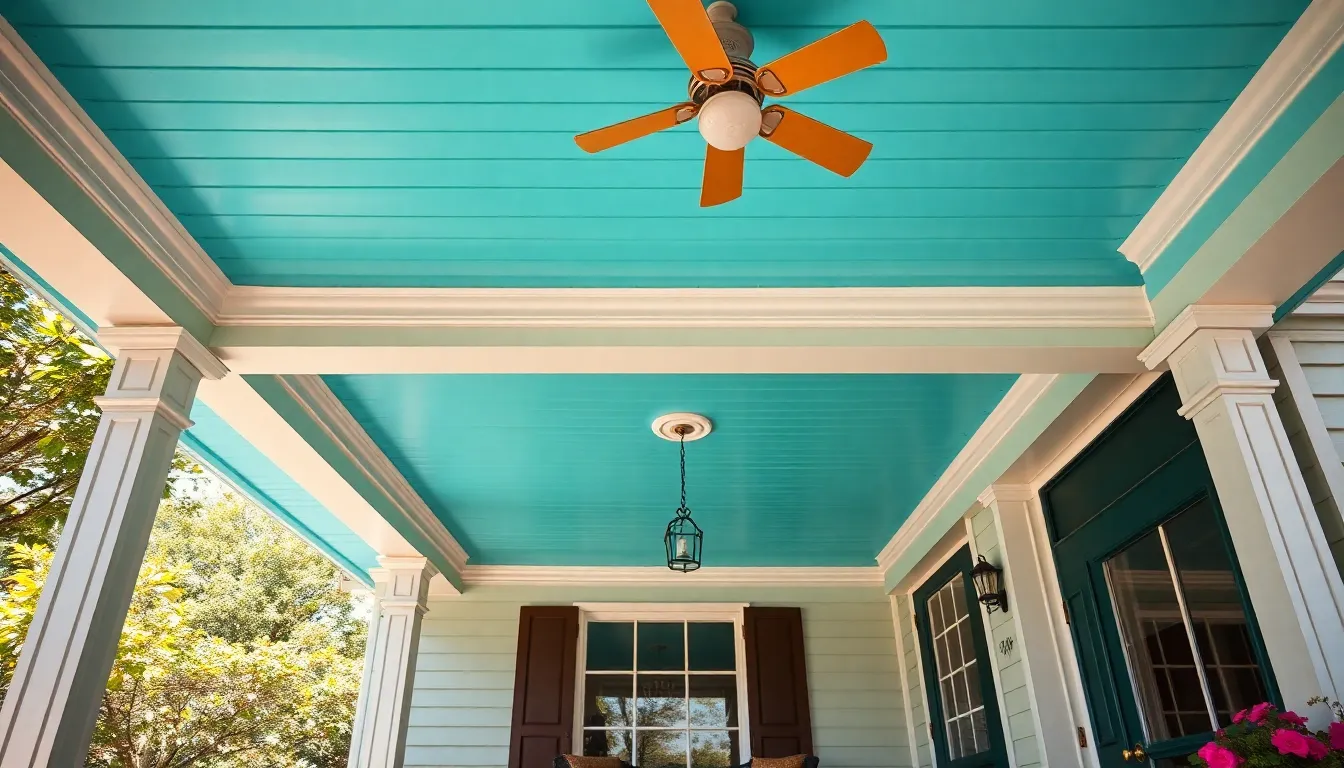
Painting your front porch ceiling opens up endless possibilities for adding personality and transforming your outdoor space. We’ve found that painted ceilings can brighten areas while influencing the entire porch’s atmosphere.
Bold Color Ceiling Statements
Blue porch ceilings create the most dramatic impact with their traditional Southern charm and practical benefits. According to regional design traditions, bright or pastel blue paint wards off insects and spirits while instantly adding a fresh, airy vibe to your space. We recommend this classic approach for homeowners seeking both function and style.
Vibrant color choices like turquoise, coral, or deep navy make striking statements that draw eyes upward. These bold options add unique contrast to exterior siding and create memorable first impressions. Studies show that contrasting colors increase visual interest by up to 40% compared to monochromatic schemes.
Contrast techniques work best when pairing bold ceiling colors with neutral or white porch trim and siding. This combination maximizes impact while maintaining visual balance throughout your porch design. We’ve seen this approach transform even the simplest porches into stunning focal points.
Subtle Painted Ceiling Tones
Soft whites and creams provide timeless, cohesive looks that match traditional exterior elements perfectly. These colors create clean, bright appearances that complement any architectural style. We find they work especially well for homeowners preferring understated elegance over bold statements.
Blush or pale pastel shades offer subtle color washes that feel uplifting without overwhelming your space. Light pastels provide gentle visual interest while maintaining the serene atmosphere many homeowners desire. These tones work particularly well in morning light conditions.
Beige or light gray options add warmth and sophistication while blending seamlessly with wood tones or natural porch elements. These neutral choices create sophisticated backdrops that enhance rather than compete with your porch furnishings and decorative elements.
Painted Ceiling Pattern Techniques
Tongue and groove boards painted in single colors enhance architectural details while maintaining clean, cohesive looks. This technique adds texture and visual interest without overwhelming your design scheme. We recommend moisture resistant paint formulations specifically designed for outdoor exposure.
Beadboard with contrasting trim creates elegant, dimensional effects when painted white with colored beams or trim elements. This approach highlights existing architectural features while adding depth to flat ceiling surfaces. Color combinations like white beadboard with navy trim have become increasingly popular.
Stencil and pattern applications allow for custom flair through geometric shapes, subtle stripes, or floral designs. Artistic painted patterns personalize your porch ceiling beyond standard solid colors. We suggest testing pattern scales on sample boards before committing to full installations.
Coffered or beamed looks emerge when painting recessed sections or beams in complementary shades. This technique highlights architectural features while adding visual depth to your ceiling design. Combining different paint sheens can further emphasize these dimensional elements.
Lighting Integration Ceiling Solutions

We’ve explored various ceiling materials and finishes, but integrating lighting takes your front porch design to the next level. Proper lighting transforms both the functionality and ambiance of your outdoor space while complementing your chosen ceiling treatment.
Recessed Light Ceiling Designs
Recessed lighting offers sleek integration with virtually any ceiling material we’ve discussed. Can lights work exceptionally well with beadboard, tongue and groove, and coffered ceiling designs because they maintain clean lines without visual obstruction. LED recessed fixtures provide energy efficiency and adjustable brightness levels, making them ideal for both ambient and task lighting needs.
Installing recessed lights between exposed beams creates dramatic architectural interest while maintaining functionality. False beams in coffered ceiling setups accommodate lighting fixtures beautifully, balancing character with practical illumination. This approach works particularly well with vaulted porch ceilings where traditional fixtures might appear oversized or intrusive.
Strategic placement of recessed lights ensures even coverage across your porch area. We recommend spacing fixtures 6 to 8 feet apart for optimal light distribution, adjusting based on your porch’s exact dimensions and desired brightness levels.
Fan Installation Ceiling Modifications
Ceiling fans enhance air circulation and extend your porch’s usable season, but they require structural planning during the design phase. Electrical hookups and mounting points must be integrated into the ceiling framing to support heavier fan units safely. Larger beams and reinforced rafters become essential for installations in vaulted or timber beam ceilings.
Planning fan placement early allows for seamless integration with your chosen ceiling material. Beadboard and tongue and groove installations can incorporate fan mounting boxes during the initial construction, maintaining the ceiling’s visual continuity. The electrical boxes remain hidden within the ceiling structure while providing secure mounting points.
Fan styles range from classic to contemporary, allowing you to match your porch’s aesthetic perfectly. Traditional fans complement rustic wood beam ceilings, while sleek modern designs work well with painted or coffered treatments.
Pendant Light Ceiling Preparations
Pendant fixtures add decorative focus and functional task lighting near entryways or seating areas. Ceiling designs must accommodate secure electrical boxes and proper mounting hardware before installation begins. Higher ceilings or recessed beam areas provide necessary clearance for pendant suspension and appropriate scale.
Weather rated pendant lights ensure durability in outdoor conditions while maintaining style consistency. Marine grade fixtures resist moisture and temperature fluctuations better than standard indoor options. Coordinating pendant styles with your ceiling material creates cohesive design flow throughout your porch space.
Layered lighting approaches combine pendant fixtures with recessed lights for comprehensive illumination. This technique allows for task lighting over exact areas while maintaining general ambient lighting across the entire porch. Strategic placement of electrical rough ins during ceiling construction accommodates future lighting changes and upgrades.
Conclusion
We’ve explored many front porch ceiling possibilities that can dramatically enhance your home’s outdoor living space. From classic beadboard and elegant coffered designs to modern bamboo panels and creative fabric draping each option offers unique benefits and aesthetic appeal.
The key is selecting materials and designs that complement your home’s architecture while reflecting your personal style. Whether you’re drawn to rustic exposed beams or sleek painted finishes the right ceiling treatment will create an inviting atmosphere that welcomes guests and family alike.
Remember that proper installation and weather-resistant materials are essential for long-lasting results. With thoughtful planning and attention to detail your front porch ceiling can become a stunning focal point that adds both value and character to your home’s exterior.
Frequently Asked Questions
What are the most popular front porch ceiling materials?
The most popular front porch ceiling materials include beadboard, tongue and groove wood planks, coffered panels, tin ceiling tiles, bamboo panels, and exposed beams. Beadboard remains a classic choice due to its timeless appeal and ease of installation. Each material offers unique aesthetic benefits and can be customized with paint, stain, or natural finishes to complement your home’s style.
Can I install a porch ceiling myself?
Yes, many porch ceiling projects are DIY-friendly, especially beadboard and tongue and groove installations. These materials typically feature interlocking systems that simplify the process. However, more complex designs like coffered ceilings or electrical work for lighting integration may require professional assistance. Always ensure proper preparation and use moisture-resistant materials for outdoor applications.
How do I choose the right ceiling color for my porch?
Choose ceiling colors that complement your home’s existing palette and desired atmosphere. Light colors like soft whites and creams create a timeless, airy feel, while bold colors like blue or turquoise add dramatic impact. Consider your porch’s lighting conditions and surrounding landscape. Neutral tones blend seamlessly with natural elements, while contrasting colors can highlight architectural features.
What maintenance do porch ceilings require?
Porch ceiling maintenance varies by material but generally includes regular cleaning, inspection for damage, and periodic refinishing. Painted surfaces may need touch-ups every few years, while stained wood requires resealing. Bamboo panels need moisture control and occasional oiling. Fabric draping should be cleaned seasonally and replaced when weathered. Proper ventilation helps prevent moisture-related issues.
How much does a porch ceiling renovation typically cost?
Porch ceiling renovation costs vary significantly based on materials, size, and complexity. DIY beadboard projects can cost $3-8 per square foot for materials, while coffered ceilings range from $15-30 per square foot. Professional installation adds labor costs. Bamboo panels and tin tiles fall in the mid-range, while fabric draping is often the most budget-friendly option.
What’s the best ceiling option for extreme weather conditions?
For extreme weather, choose durable materials like cedar tongue and groove, treated pine, or marine-grade composite materials. These resist moisture, insects, and temperature fluctuations. Proper sealing and ventilation are crucial. Avoid fabric draping in areas with severe weather. Metal tin ceilings with appropriate coatings also perform well in harsh conditions when properly installed and maintained.
Can I add lighting to my porch ceiling design?
Yes, lighting integration enhances both functionality and ambiance. Popular options include recessed lights that blend with ceiling materials, ceiling fans for air circulation, and pendant lights for decorative focus. Plan electrical work during the design phase for seamless integration. Consider dimmable options and weather-resistant fixtures. Professional electrical installation is recommended for safety and code compliance.
How do I prevent moisture damage in porch ceilings?
Prevent moisture damage by using appropriate materials like moisture-resistant beadboard or treated lumber. Ensure proper ventilation and drainage around the porch area. Apply quality sealers, paints, or stains designed for exterior use. Regular maintenance including cleaning and inspection helps identify issues early. Consider the porch’s exposure to rain and humidity when selecting materials and finishes.

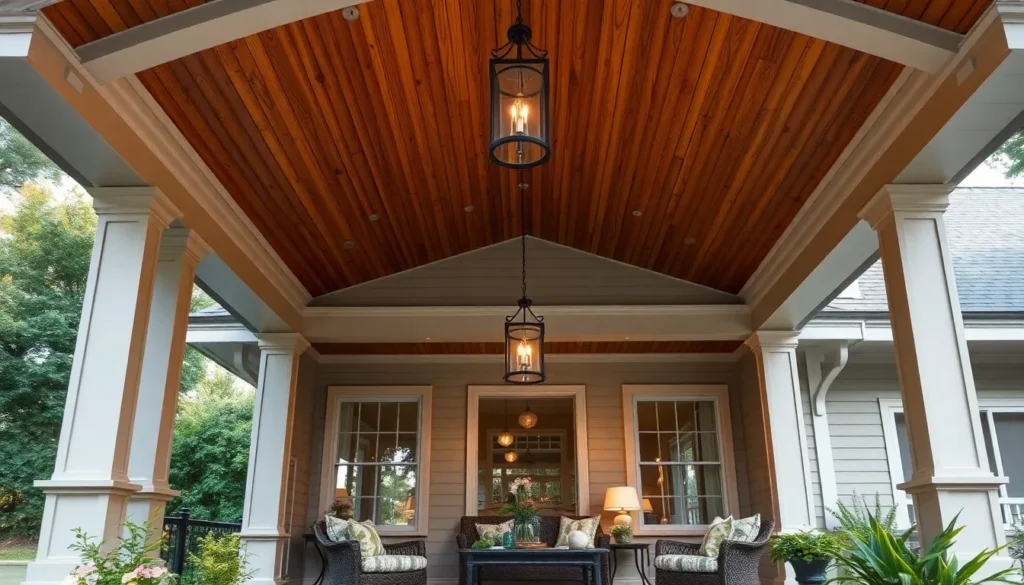
![American Tin Ceilings [5 Pack] 24" x 24" 100% Tin](https://m.media-amazon.com/images/I/61rHsCLF8dL._SL500_.jpg)









